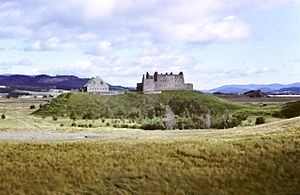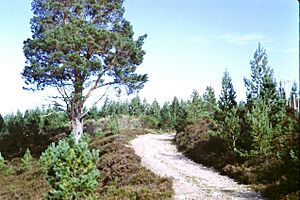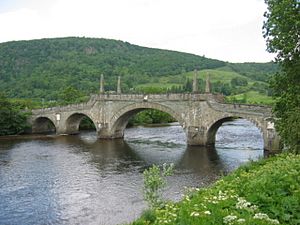George Wade facts for kids
Quick facts for kids
George Wade
|
|
|---|---|

Field Marshal George Wade
|
|
| Born | 1673 Killavally, Westmeath, Ireland |
| Died | 14 March 1748 |
| Allegiance | |
| Service/ |
|
| Years of service | 1690–1748 |
| Rank | Field Marshal |
| Battles/wars | |
| Signature |  |
George Wade (born 1673 – died 14 March 1748) was an important British Army officer. He served in several major wars, including the Nine Years' War and the War of the Spanish Succession. Later, he became famous for building new roads, bridges, and army camps in Scotland. He also led British forces during the War of the Austrian Succession and the Jacobite rising of 1745.
Contents
Early Military Career
George Wade was born in Killavally, County Westmeath, Ireland. He spent his early years in English Tangier, where his father was a soldier. Wade joined the army on 26 December 1690. He served in Flanders in 1692 and fought in the Battle of Steenkerque during the Nine Years' War. He was promoted to lieutenant in 1693 and captain in 1695.
During the War of the Spanish Succession, Wade fought alongside famous commanders like Marlborough. He took part in several battles in 1702, including Kaiserwerth and Liège. He was promoted to major in 1703 and lieutenant colonel later that year. In 1704, he went to Portugal and was wounded at the Battle of Alcántara in 1706. He became a brigadier general in 1708.
Wade also served in Menorca in 1708, helping to capture Fort St. Philip. He returned to Spain in 1710 and fought at the Battle of Saragossa. By 1714, he was a major-general and commander of British forces in Ireland.
After returning to Britain, Wade helped stop the Jacobite rising of 1715. He found many hidden weapons in Bath. In 1715, he also became a Member of Parliament (MP) for Hindon.
In 1719, Wade was second-in-command during a raid on the Spanish coast. This was part of the War of the Quadruple Alliance. British troops captured Vigo and held it for ten days. Wade also supported the Royal Academy of Music, which brought opera to London. He became an MP for Bath in 1722 and kept this role for 25 years. His house near Bath Abbey is now a historic building.
Building Roads in Scotland
In 1724, King George I sent Wade to inspect Scotland. Wade suggested building new army camps, bridges, and good roads. These would help the government control the country. On 10 May 1725, he was put in charge of all British forces in Scotland. His main job was to carry out his own plans.
Over the next twelve years, Wade oversaw the building of about 240 miles (386 km) of roads. He also built 30 bridges, including the famous Wade's Bridge at Aberfeldy. These military roads connected important forts like Ruthven, Fort George, Fort Augustus, and Fort William.
There is a famous saying about his roads:
If you had seen this road before it was made,
You would lift up your hands and bless General Wade.
Wade also created a special militia called the "Highland Watches." These were groups of local people who helped keep order. He formed the first six companies in 1725. Later, in 1739, he formed four more companies. These groups eventually became the famous Black Watch regiment. Wade was promoted to lieutenant general in 1727 and general of horse in 1739.
Later Military Commands
In 1743, George Wade became a field marshal. He was given joint command of the British and Austrian forces in Flanders. This was during the War of the Austrian Succession. Wade planned an attack towards Lille in 1744, but his army faced many problems. He resigned from this command in March 1745. He then returned home to become Commander-in-Chief of the Forces for all of Britain.
The Jacobite Rising of 1745
In October 1745, the Jacobite rebellion began. Wade gathered his troops in Newcastle upon Tyne, on the east coast of England. However, the Jacobite forces moved very quickly down the west coast. They marched through Carlisle into Lancashire. Wade's army struggled in the freezing weather and with little food. He could not stop the Jacobites from marching into England or from retreating back to Scotland.
Wade was later replaced as Commander-in-Chief by Prince William, Duke of Cumberland. Cumberland's army went on to win the Battle of Culloden in April 1746.
Because of the difficulties Wade faced moving his troops, he helped plan a new Military Road west of Newcastle. This road was built starting in 1751, after Wade had passed away. It is still used today as the B6318.
Around 1745, a verse about Marshal Wade was added to the song "God Save the King":
Lord, grant that Marshal Wade
May, by thy mighty aid,
Victory bring.
May he sedition hush
And, like a torrent, rush
Rebellious Scots to crush.
God save the King.
Personal Life
George Wade never married. He passed away on 14 March 1748. He is buried at Westminster Abbey, where a monument honors his life. Wade left most of his money and property to his children. He also made sure to provide for his brother's family.
Images for kids





